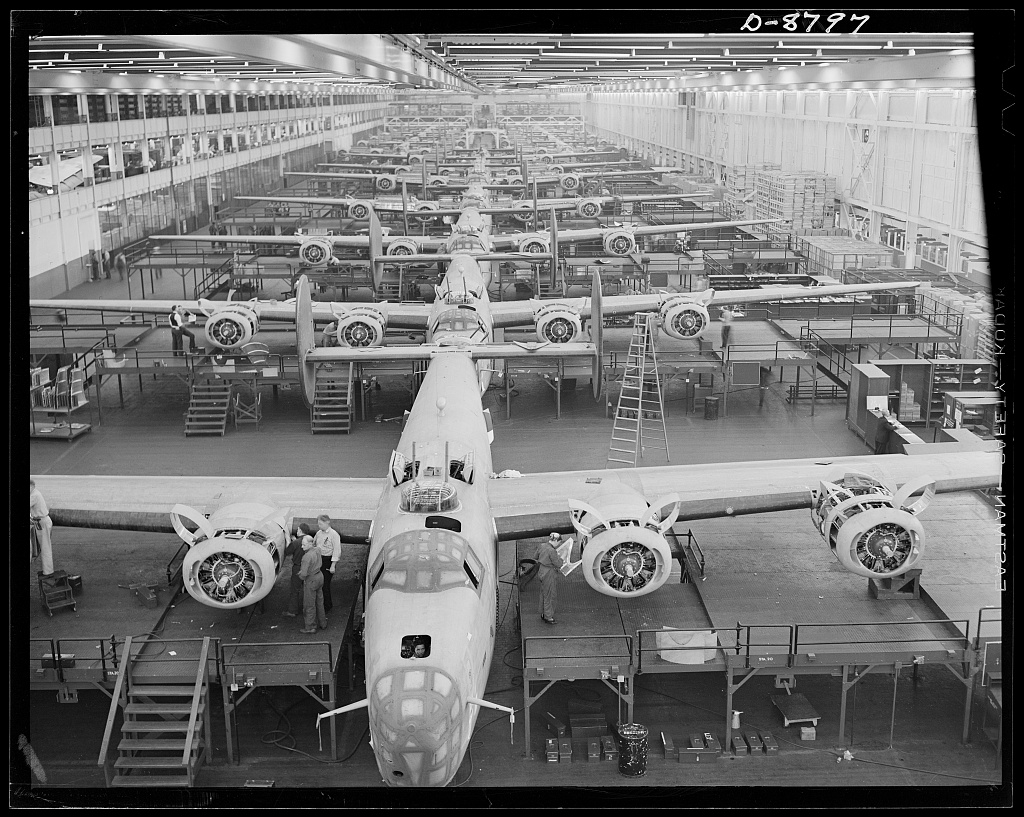There’s a pivotal moment in Ford v. Ferrari when Henry Ford II explains why the American automaker is going to defeat the Italian one.
It’s a great scene as played (by Tracy Letts and Matt Damon) and it’s a great scene as written, by Jez Butterworth, John-Henry Butterworth, and Jason Keller.

I’d be lying if I claimed I didn’t enjoy it, or the rest of the movie. But it is, of course, total nonsense in any number of ways.
The germ of truth there is that Ford did build a lot of B-24 Liberator bombers at the Willow Run plant it operated in Ypsilanti, Michigan. David M. Kennedy says about half the 18,000 or so Liberators built during the war came from Willow Run, and that at peak efficiency, the plant turned out one every sixty-three minutes.1

So Willow Run was run by Ford and it did build a lot of bombers that were vital to the Eighth Air Force’s bombing campaign in Europe. Especially before D-Day, the long-range B-24 presented the best hope of striking deep into the heart of the continent. (Although if you know anything about the Ploesti raid, you know that hope was far too costly to realize until long-range fighters were generally available.)
But of course, (A) about half the B-24s is nowhere near three-fifths of the bombers and (B) the bombing campaign didn’t defeat Hitler, though it certainly made a difference.
Maybe most important, Ford didn’t build the plant. Let’s look at the relevant page in the report on War Industrial Facilities Authorized July 1940–August 1945.2

Maybe the writing there is a bit small. It says, “Willow Run Airplane Factory, Ypsilanti Mich, New Plant; Heavy Bombers, B-24, Additional sub-assemblies.” Then it says, “Total cost, $94,898”—that’s in thousands of dollars, so about $95 million. Then it says that of the total cost of $94,898,000, the public funds contributed were $94,898,000. In other words, all of it. As you can see, under “Privately financed,” there is the entry “–”.
Mark Wilson did his best to make this point in Destructive Creation, but I guess the Ford v. Ferrari writers didn’t read it. Wilson notes that not only did the federal government foot the bill for this, as it did for much wartime construction, it actively ran the programs, setting costs, specification, laboring conditions, and lots more. To use the case of the B-24 as a continuing example, the bomber was originally developed by Consolidated Aircraft of San Diego, and Roosevelt administration officials grew dissatisfied with its progress in 1941. One wrote that “I have never seen so large an outfit run as ‘haphazardly’ as this one.”3 So, as Wilson notes, the administration edged out Consolidated’s CEO, facilitated the firm’s takeover by Vultee and the installation of Tom Girdler (formerly of Republic Steel) to run it.4 Girdler, Time alleged, had by then “made his peace with Franklin Roosevelt and the C.I.O.”
So no, it wouldn’t be right to say that “Roosevelt beat Hitler,” of course. But it’s not right to say that Willow Run was exactly Henry Ford’s doing, either.
Footnotes
David M. Kennedy, Freedom from Fear: The American People in Depression and War, 1929–1945 (New York: Oxford University Press, 1999), 653–54.↩︎
United States, Civilian Production Administration, War Industrial Facilities Authorized July 1940–August 1945 (Washington, DC: Civilian Production Administration, 1946).↩︎
J. Carlyle Sitterson, Aircraft Production Policies Under the National Defense Advisory Commission and Office of Production Management, May 1940 to December 1941 (Washington, DC: War Production Board, 1946), 153.↩︎
Mark Wilson, Destructive Creation: American Business and the Winning of World War II (Philadelphia: University of Pennsylvania Press, 2016), 209.↩︎